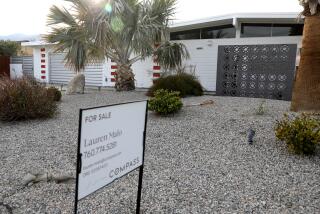More real estate listings to detail homes’ disabled access features
- Share via
On the heels of the movement to add green features to multiple listing service postings, listing accessibility features is also gaining steam.
Local listing services are not required to highlight extra-wide doorways that can accommodate wheelchairs, first-floor master bedrooms, entry thresholds that are even with the sidewalk, grab bars in the bathroom, lever doorknobs and faucets, and other such features. But they should.
After all, according to the latest figures from the Census Bureau, nearly 20% of the population has some kind of disability. That’s almost 57 million people. Of course, not all of them are severely handicapped, but about half are.
Moreover, between 2005 and 2010, the number of folks with a disability increased by 2.2 million. And in 2010, roughly 30.6 million people had difficulty walking or climbing stairs, or used a wheelchair, cane, crutches or walker.
According to the National Assn. of Realtors, the South Central Wisconsin Multiple Listing Service was the first to include accessibility terms, way back in 1991. When agents submit a property for listing, they can check up to 15 accessibility features, including ramped entries, 42-inch-wide hallways and doorways and roll-in showers.
Several other listing services have since followed Wisconsin’s lead, but it wasn’t until two years ago that a movement began to add accessibility terms to the standard real estate data dictionary. That effort is being led by the Real Estate Standards Organization, a private entity dedicated to creating voluntary electronic commerce standards so they are the same everywhere.
Uniformity is “really crucial,” says Bill Lubin, a Philadelphia broker and outgoing chair of the National Assn. of Realtors’ MLS Issues and Policies Committee.
Without an agreed-upon set of standards, Lubin explains, there is no easy-entry data field for agents to check off when listing houses for sale. So “they must be marketed in the notes section” of the listing, and the result is they don’t pop up during searches.
According to the real estate group, 23 of the country’s largest multiple listing services support the effort to standardize accessibility terms. Now smaller services are signing on too, adding such common terms as low-profile carpeting, swing-in doors, entry slopes that are less than one foot, doorbells that flash the lights inside the house, higher toilets and lower light switches.
The most advanced services also list features that make some communities more livable than others, such as safe streets, outdoor places where the disabled can gather and public transportation options.
Now, all 800 or so multiple listing services across the land are being asked to present accessibility features in a single data field starting early next year. That way, would-be buyers who use wheelchairs or have some other major disability can more easily hunt for houses that meet their physical requirements.
So, if you are selling a home with accessibility features, make sure your agent checks off those items in the appropriate box to attract the widest possible audience of home seekers. And if you are a buyer, have your agent search the multiple listing service by one or more of those features. You might get lucky and spare yourself a lot of wasted time searching for places that just won’t work.
On the environmental front, a new website has appeared in Southern California to help buyers connect with agents who are trained to help them find homes with green features and to take advantage of energy rebates and financing initiatives.
The site, greenhomeagents.com, is sponsored by the Energy Network, a government organization administered by Los Angeles County. It links buyers across the nine-county region to agents who have completed the National Assn. of Realtors’ Green Designation courses and can advise them about the range of green features.
Dan Knapp, senior marketing manager at Build It Green, which runs the program on behalf of the Energy Network, says some 460 real estate professionals and nearly 50 appraisers have been trained so far in the art of buying, selling and appraising sustainable houses. And many more are in line.
“We’re seeing a high demand” among these pros, Knapp says. “They see that the market is going that way and they are responding.” An agent with the green designation can “get people thinking about energy costs,” he adds, and help them “get more home for their money.”
The response among the real estate community has been so great that the program will soon be offered in the San Francisco Bay Area and, later, other parts of the state.
Distributed by Universal Uclick for United Feature Syndicate.
More to Read
Sign up for Essential California
The most important California stories and recommendations in your inbox every morning.
You may occasionally receive promotional content from the Los Angeles Times.






